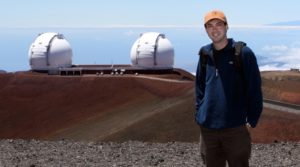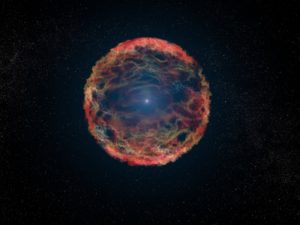Bizarre Discovery Challenges Existing Theories on Supernovae
A recent discovery including data gathered at W.M. Keck Observatory on Maunakea is challenging existing theories on supernovae, or the explosion of stars.
Supernovae usually mark the final death of a star. But an international team of astronomers led by Las Cumbres Observatory (LCO) has found a star that has exploded multiple times over a period of more than fifty years. Their findings were published Nov. 8, 2017, in the journal Nature.
“The spectra we obtained at Keck Observatory showed that this supernova looked like nothing we had ever seen before,” said Peter Nugent, senior scientist and division deputy for science engagement at the Computational Research Division of Lawrence Berkeley National Laboratory who coauthored the study. “This, after discovering nearly 5,000 supernovae in the last two decades. While the spectra bear a resemblance to normal hydrogen-rich core-collapse supernova explosions, they grew brighter and dimmer at least five times more slowly, stretching an event which normally lasts 100 days to over two years.”
Researchers used the Low Resolution Imaging Spectrometer (LRIS) on the observatory’s Keck I telescope to obtain light from the star’s host galaxy, and the Deep Imaging and Multi-Object Spectrograph (DEIMOS) on Keck II to obtain high-resolution spectra of the unusual star itself.
The supernova, named iPTF14hls, was first discovered in September of 2014 by the Palomar Transient Factory. It looked like an ordinary supernova at first glance. But several months later, LCO astronomers noticed it was growing brighter again after fading.

Lead author Iair Arcavi, a NASA Einstein postdoctoral fellow at LCO and the University of California Santa Barbara, visiting the Keck Observatory twin 10-meter optical/infrared telescopes on Maunakea, Hawai‘i. Credit: I. ARCAVI.
Astronomers looked back to archival data where they found an explosion at the same location as iPTF14hls in 1954. This star had somehow survived that previous explosion and then exploded again in 2014.
“This supernova breaks everything we thought we knew about how they work,” said lead author Iair Arcavi, a NASA Einstein postdoctoral fellow at LCO and the University of California Santa Barbara. “It’s the biggest puzzle I’ve encountered in almost a decade of studying stellar explosions.”
The study calculated that the exploding star was at least 50 times more massive than the Sun and probably much larger. Supernova iPTF14hls may be the most massive stellar explosion ever observed by astronomers. The size of its explosion could be the reason that conventional astronomical theories of supernovae fail to explain the event. Supernova iPTF14hls may be the first example of a “Pulsational Pair Instability Supernova.”
“According to this theory, it is possible that this was the result of a star so massive and hot that it generated antimatter in its core,” said co-author Daniel Kasen, an associate professor in the Physics and Astronomy Departments at UC Berkeley and a scientist at Lawrence Berkeley Lab. “That would cause the star to go violently unstable, and undergo repeated bright eruptions over periods of years.”
That process may even repeat over decades before the star’s final explosive collapse into a black hole.
“These explosions were only expected to be seen in the early universe and should be extinct today. This is like finding a dinosaur still alive today. If you found one, you would question whether it truly was a dinosaur,” said Andy Howell, leader of the LCO supernova group and co-author of the study.
The “Pulsational Pair Instability” theory may not fully explain all the data obtained for this event, and it may be a completely new phenomena. Astronomers are continuing to monitor iPTF14hls, which remains bright three years after it was first discovered.
“This is one of those head-scratcher type of events,” said Nugent. “At first we thought it was completely normal and boring. Then it just kept staying bright, and not changing, for month after month. Piecing it all together, from our observations at Palomar Transient Factory, Keck Observatory, LCOGT, and even the images from 1954 in the Palomar Sky Survey, has started to shed light on what this could be. I would really like to find another one like this.”











